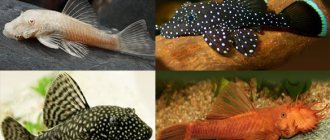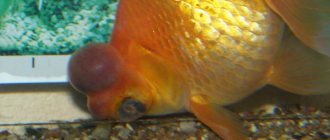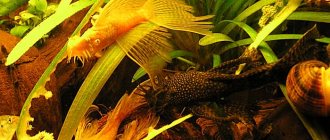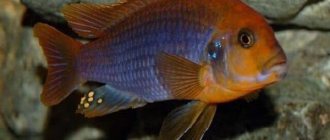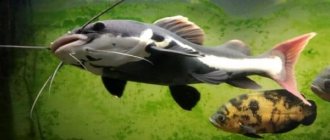“Cleaners”, “stickers”, “suckers” - all these names belong to one type of catfish - ancitrus. This, at first glance, awkward fish is popular among aquarists for its unpretentiousness and the benefits it brings to the aquarium. Before you buy this fish, study it carefully and look at the photo. Under its guise, they often sell catfish pterygoplichts or plecostomus, which grow up to 40 centimeters and can bring a lot of trouble to their owner.
Description
This catfish, like many other fish, was discovered in South America, and it came to us only after 1970. The fish got into home aquariums primarily because of its exotic appearance:
- due to its benthic lifestyle, the Ancistrus body has a teardrop-shaped, flattened shape;
- There are bony plates throughout the body designed to withstand predators;
- the color depends on the specific breed of fish;
- The main difference from other catfish is the shape of the mouth - it looks like a suction cup.
These fish do not grow too large - they reach a length of 20 centimeters. With proper care, they can live up to 7 years in a home aquarium, although in nature they most often die earlier.
Diseases
These fish are especially susceptible to helminths (parasitic worms) due to their special diet. Therefore, to avoid diseases, it is better to add special products to the food. In addition, often these catfish may experience difficulties with the gastrointestinal tract, namely constipation, bloating, etc. For the most part, this is due to poor diet. Therefore, do not forget that ancistrus need driftwood and plant food, as well as vegetables.
If you follow the “menu” for these pets and do not forget about good care, then they will certainly delight the owner of the aquarium for several years.
We recommend reading the article: Diseases of aquarium fish
Kinds
Ancistruses amaze with their diversity. The following types can be found in aquariums:
- Ordinary or blue - before puberty, the scales are distinguished by a bluish color, and then it becomes dark gray or yellowish-gray with chaotically located white spots.
- Veiled (Dragonfly) – The beauty of this Ancistrus is that its fins are overly enlarged. They flutter beautifully as they move around the aquarium. The body color of the fish is dark olive with small white specks.
- Yellow is another common species and has a yellow-orange body.
- Star-shaped - this species has a color so dark that small white spots stand out on it, like stars in the night sky. In young animals up to one year old, the fins are edged with blue, and in adults, small spines are visible on them.
- Starfish - differs from the previous type in its fins: the pectoral fins are thickened, and the dorsal and caudal fins are edged with white. When in danger, this fish releases hard spines from the base of its head.
- L-184 is the rarest catfish, it is also called diamond for its increased diameter of spots. The color of the fish is rich black, it does not change throughout its life.
- Red – this breeding species is suitable for those who prefer the fish to be active during the day. Ancistrus of this type has a red or slightly orange body color. Its size is small - up to 6 cm.
- Golden albino - the fish received a beige-golden color due to a genetic error; its scales are not pigmented. Another characteristic feature of her is the red tint of her eyes. The disadvantage of this catfish is its short life expectancy.
- LDA-016 - has an unusual brown color with dark spots, for which it is nicknamed the leopard look. With age, the contrast of its color becomes more noticeable. Sometimes gray spots can be distinguished on the body, in which case the breed is called brindle or tricolor.
Licensed species are expensive, so they are rarely found in ordinary aquariums. It is best to choose one of the types of ancistrus: yellow, veil or ordinary.
How to distinguish Ancistrus from Pterygoplichts
Chain catfish are similar to each other, so even at the purchase stage you need to be able to distinguish them. There are several signs that will allow you to choose the ancistrus:
- its young have a light edging on their fins;
- There are small horns on the top of the head, and no mustache on the bottom;
- many colors of scales;
- absence of a pattern on the scales characteristic of Pterygoplichthus.
Making the right choice is easy if you do your homework before purchasing your fish.
Neighborhood among brothers
If we consider the intraspecific relationships of Ancistrus, then the concept that Ancistrus is a peaceful fish will be a little vague and not very correct. As one aquarist said - a peaceful fish under normal conditions!
What can be understood by normal conditions in the life of ancistrus? This, unfortunately, is not the conditions of detention, water parameters, length of daylight hours, or the regularity and variety of food.
Normal conditions in the life of these catfish can be called circumstances in which no one will need to prove or defend anything. What does it mean?
Normal conditions are when there is one pair of catfish in the aquarium, there is no need to take food from anyone, the male does not need to prove superiority over other males, when everyone has enough shelter and living space. Now let's look at these points in a little more detail.
Editorial: Danio tinvini
Living space
As you know, even guppies will be reluctant to live in a three-liter jar. It's the same story with catfish. If you keep ancistrus in a common aquarium, then for one pair you need about 60-70 liters for comfortable living.
If you plan to keep more individuals, then approximately the same volume will be needed for each pair. Why, and what can happen if you do not follow this instruction?
A similar situation can arise in a fairly spacious aquarium that does not have enough hiding places. Ancistrus will also fight for apartments, so if you plan to keep more than 2 individuals of these catfish, then try to provide them with grottoes, caves, amphorae, halves of coconut shells and, of course, driftwood.
Snags are a separate point in the life of ancistrus. In addition to the fact that this is a natural shelter for this catfish, it is also food. By scraping off a layer of wood, catfish saturate the body with useful substances that help maintain health at the proper level.
Guests
When all your inhabitants in the aquarium have already gotten acquainted and come to some common denominator, everything seems to have become quiet and peaceful, no one is chasing anyone or getting nervous. But a resonance can be caused by new ancistrus that you add to this aquarium.
As before, males and females will need to show who is boss and let newcomers know where their place is. If we are talking about a spacious aquarium with a lot of space and hiding places, then such conflicts usually end quite quickly.
Fathers and Sons
As you know, after the female lays eggs, she needs to be removed from the aquarium or the spawning ground must be equipped with many shelters. This is due to the fact that the bearded loving ancistrus, after completing the spawning process, becomes an aggressive defender of the future offspring. And his aggression is so great that in some cases the females died under the pressure of a fierce defender.
The father carefully waves his fins near the eggs, stimulating the flow of water to the future babies, removes unfertilized or dead eggs from the clutch, and this will continue until the larvae begin to swim. Only after a couple of days can dad calmly return to his business.
But if we consider a common aquarium in which a couple of ancistrus spawned, then after a while, or rather after 7-10 months, when the fry reaches sexual maturity, the sons will already be regarded as competing males, and there will no longer even be any family connection in mind. Then the rule “who is stronger is right” comes into play.
Maintenance and care
It is easy to create suitable conditions for ancistrus:
| Parameter | Description |
| Shape and volume of the aquarium | Choose wide and long aquariums, with a volume of 80 liters or more when keeping a couple of fish. The bottom area should be maximum. |
| Filling the aquarium | You need to place a lot of decorations, shelters, castles, grottoes, and large stones in the tank. It is best to choose fast-growing plants that Ancistrus will use as feeding. For normal digestion, place natural driftwood on the bottom, which the fish can gnaw on. At the same time, it will give them a more attractive look. |
| Saturation of water with oxygen | The bottom of the aquarium has the lowest concentration of oxygen, so installing an aerator is mandatory. With it, catfish will not have to float to the upper layers of water, they will not be irritated because of this. |
| Temperature | In cool water (22-24 degrees), ancistrus are more comfortable, but in warmer water their growth stops prematurely. |
| Lighting | It is advisable to equip areas with constant shade in the aquarium, then the long daylight hours will not disturb the bottom inhabitants. If you were unable to create shaded areas, choose dim lamps. The easiest way to equip a shelter for ancistrums is to tie anubias to driftwood or plant them in an aquarium. |
| Daylight hours | The periods of day and night should be equal; when transitioning from one to the other, a half-hour twilight must be arranged. |
| Priming | It should not be too fine; smooth gravel will do. In search of food, catfish constantly feel the pebbles. If they are small, the fish will swallow them, and this will end in disaster. |
| Water renewal | Do not forget to organize a moderate flow in the aquarium and regularly change up to a third of the water in it to clean water. |
Distribution area
Ancistrus catfish is found in nature most often in the Amazon basin, as well as in other rivers of South America, the water in which meets the following parameters:
- pH 6;
- hardness 4-5 °dH;
- strong current;
- daylight hours about 12 hours;
- water temperature from 20 °C.
There are many species of ancistrus, so in the nature of South America it can be found both in swampy streams and in deep-water rivers in shaded areas of the bottom.
Photo gallery:
Feeding
Ancistrus are vegetarians who prefer to obtain food on their own. They regulate the growth of algae and gnaw snags.
Additionally, they need to be given:
- industrial feeds, balanced for chainmail or based on spirulina algae;
- boiled greens: cabbage, lettuce or nettle leaves;
- fresh pieces of vegetables: broccoli, carrots, zucchini, cucumber.
Fresh pieces should be large so that the catfish can gnaw them. This is a very unusual sight. Cucumbers and zucchini are cut into slices, and broccoli is given as an inflorescence. Do not keep vegetables in the aquarium for a long time so as not to pollute the water. Use them as complementary foods. Give the main meals in the dark.
Features of behavior
Ancistrus does not like light . This is the first rule. If you want to enjoy the beauty of the fish, you will have to give up bright lighting. Under the cover of darkness, these cleaners swim out to fight plaque and methodically move their scraper mouths over all surfaces.
The second rule is that Ancistrus does not like to be hungry . If he is hungry, he may begin to scurry back and forth unhappily along the front wall of the aquarium, begging for food.
The third rule is that ancistrus have different characters . While one can behave like a true gentleman, carefully avoiding obstacles and without disturbing the appearance of the home, another exactly the same ancistrus can:
- lie on your belly on the leaves of living plants and break them off
- gnaw out the most tender leaves from which the plant grows
- enjoy some plants whole
Ancistruses become stubborn and grouchy with age, so to speak. They are more sensitive to their territory, are completely calm about loneliness and can even kill a new neighbor whom they will share with him “so that he won’t be sad.” Therefore, the fourth rule is to respect old age and think about it in advance . It is better to buy young catfish, several at a time.
Fifth rule - Ancistrus females can become males . This skill is called sexual dimorphism and is inherent in many species of fish, including these catfish.
Compatibility with other fish
If you create suitable conditions for Ancistrus, they will be peaceful and calm. The best neighbors for them will be fish with similar conditions:
- gourami;
- zebrafish;
- characins;
- platies.
Many people write that they get along with goldfish, but this is not so. Often, aquarists are faced with situations where catfish attach themselves to goldfish and tear off their skin along with the meat. Ancistrus can chase phlegmatic, slow or scaleless fish during periods of bad mood and start fights.
Also, you should not put two males, territorial breeds and cichlids in the same aquarium - such proximity will lead to fierce fights that can end in failure for everyone.
The structure of the mouth allows catfish to inflict fatal wounds, but at the same time, because of it, they coexist peacefully with shrimp.
Nutrition
One of the most pressing problems in keeping ancistrus is the question of what to feed the catfish. Despite the fact that fish are able to feed on the smallest algae and plaque, pets must be fed with the following types of food:
- vegetable food tablets;
- frozen food: coretra, bloodworms;
- vegetables processed with boiling water: zucchini, pumpkin, peas, pumpkin;
- live food: tubifex, daphnia, worms, insect larvae.
When compiling a diet, it should be taken into account that plant foods should make up 80% of the volume, and protein – 20%. Not only the health of fish, but also the reproduction of catfish depends on proper nutrition.
How do they reproduce?
To prevent the eggs from being eaten by other fish, it is best to use a separate aquarium for breeding. Ancistrus ripen in about a year; you can pick a pair yourself and plant them. For a maternity tank, choose an aquarium of approximately 50-60 liters. Fill it 2/3 with water from a common container and 1/3 with clean water. Set the temperature 2 degrees lower than in the main aquarium.
The only difference in the design of the spawning tank is that it must have a special shelter for spawning. You can make it yourself by fashioning a tube out of clay, or buy a ready-made piece of pipe or a piece of driftwood that is hollow inside. Such shelter is necessary, otherwise the female will leave eggs in the most unexpected place. There were cases when she threw it into the filter.
The male chooses the place for the offspring; he can do this for several days. The future nest will definitely be thoroughly cleaned, after which the process of courtship and spawning will begin. Most often, the female lays eggs at night; in the morning they should be immediately deposited back. Parental functions are performed by the male; he can even drive the mother away from the nest at this time.
On the 5th day the larvae hatch, but for another week they will gain strength in the nest. When they begin to move independently, the male loses interest in them; he has fulfilled his paternal functions. At this time, it can be returned to the general aquarium, and the fry can be fed with special tablets for catfish three times a day. Catfish can be transferred to a community aquarium at 6 months.
How to distinguish a male from a female
Male ancistrus can boast of clearly expressed sexual characteristics - there are numerous growths on their upper jaw. They are often called mustaches, beards or horns.
It is interesting that females find these growths attractive; they give preference to those males in which this dimorphism is most pronounced.
A less noticeable feature is the size of the body: males are larger, but at the same time more graceful. Girls have a more rounded abdomen, and growths on the upper jaw are only 1 mm long.
Habitat in nature
It is found throughout the Amazon, in the Tapajos, Tefe, Trombetas, and Madeira rivers.
The word ancistrus comes from the ancient Greek agkistron, meaning horn. They got their name from the growths that form on the head of adult males.
These outgrowths resemble a beard or thick spines. For a long time, the number of spines was used to distinguish different species, but it turns out that individual individuals can have different numbers of spines depending on the time of year.
The exact mechanism for this has not yet been studied, but many experts agree that it is related to readiness to spawn.
In the aquarium, almost all species are ready for spawning at the age of about a year; accordingly, males acquire luxurious horns at about this age.
No specialist knows exactly how many different species the genus Ancistrus includes; it is often difficult to even determine subspecies.
So basically aquarists say in general terms - ancistrus, when they describe the fish that lives in their aquarium.
Content issues and helpful tips
Experienced aquarists believe that ancistrus are easy to keep. You may encounter only minor problems:
- An incorrectly chosen aquarium can lead to manifestations of aggression in catfish, even within their own species. They will guard their borders and not allow others in even to get food. It is best to have at least 40 liters of water per ancistrus.
- Since fish are active at night, they may not behave very friendly at this time. They climb onto the backs of sleeping individuals and gnaw their scales.
- Often this bottom-dwelling fish finds itself in the upper layers of water. In this case, increase the air supply by adjusting the compressor. Frequent ascents are dangerous because the catfish can climb into the filter (especially before spawning) and die there.
- There are several groups of diseases that catfish are exposed to: bacterial, viral, digestive disorders, worm infections. Regularly monitor the condition of your pets so that if there is the slightest change, remove the catfish and treat it.
It is interesting to observe the unusual habits of the ancistrus, especially during its games or feeding. If you follow the recommended conditions for keeping your pet, he will become a happy long-liver.
Reproduction
Having got a couple of catfish in an aquarium, it would be reasonable to expect offspring from the fish. You can distinguish a male from a female by small outgrowths similar to horns, which are located on the head of the ancistrus. In order for the pets to begin to reproduce, the best representatives are selected: a male and a female, which should be slightly larger than a boy.
It should be noted that during spawning many fish become aggressive, and ancistrus are no exception. Sticky catfish breed in a separate aquarium equipped with stumps, pots, snags or tubes, where the catfish lays its eggs. Despite the need to create a natural environment, the favorite place where catfish can calmly and easily reproduce is in plastic tubes. Also, during spawning, aquarists thoroughly clean the fish tank and install a filter and aerator to provide the pets with favorable conditions for reproduction.
The caring parent in a couple of catfish is the male Ancistrus. As soon as the fish has stuck and laid eggs, the male selflessly guards and fans the eggs with his fins to provide oxygen to the future offspring, and the father catfish also removes the dead eggs.
The larvae emerge from the eggs after five days. All this time, Ancistrus guards the babies, who practically do not move for two weeks. After this time, aquarists begin feeding the fry, giving the small catfish spirulina and ciliates, and later introduce plant and protein foods into the diet. Sticky catfish are interesting and useful aquarium inhabitants that will help the owner maintain cleanliness and order in an artificial pond. Despite the lack of bright and rich colors, ancistrus are unpretentious, energetic and hardy fish, for which many aquarists value sucker catfish.
Short story
Ancistrus are a very popular aquarium fish, known since the early 1900s, that have earned a reputation as champion algae killers.
Unfortunately, both before and now there is confusion in the identification of species of the genus Ancistrus. The situation is further complicated by hobbyist aquarists who give different, speculative scientific names to almost every imported species. The most common among them are: A. cirrhosus, A. temminicki and A. dolichopterus. Although most wild specimens are extremely difficult to assign to a specific species, the situation has improved slightly in recent years.
Ancistrus cf. cirrhosus was for a long time known simply as Ancistrus sp. (3). This is the most common and accessible of the ancistrus, coming to the market from fish farms in Southeast Asia and Florida. Its specific characteristics have not been determined, so there is still an opinion that it is a hybrid. However, this is doubtful because the species has been bred for a long time without any variation, and specimens found in Europe, Australia and the United States appear to be the same species. Breeding practices have led to the emergence of albino (A. sp. 4), veiled (A. sp. 5) and even albino veiled forms.
Ancistrus cf. cirrhosus (Ancistrus sp. (3)) with juveniles (ill. www.istellas.gr)
Ancistrus triradiatus (aka LDA 72) is most often exported in the wild. Representatives of this species are caught in large quantities near the city of Villavicencio, Colombia. They inhabit waters at the base of mountains and can withstand relatively low temperatures (down to 22 °C). These catfish prefer fast water with a high oxygen content, but adapt to other conditions.
Ancistrus triradiatus (LDA 72) (ill. dfcdfc69; alquimistadeacuarios.com/foro/viewtopic.php?t=50031)
True specimens of Ancistrus dolichopterus (aka L183) are supplied from Rio Negro, Manaus. These attractive blackwater inhabitants require soft, warm water.
Why do ancistrus have antennae?
Sabaj and colleagues (Sabaj et al., 1999) proposed a very interesting and plausible reason why male ancistrus develop a shaggy nose. In their studies, they found that males often guard several broods at the same time. In addition, scientists noted the preferential mating of females with males who are already guarding the brood and, perhaps, thus demonstrating the success of their reproductive strategy. In this case, the antennae developing on the muzzle theoretically reproduce the movements of the larvae and make the female believe that the male is already a successful parent and, therefore, a good sexual partner.
